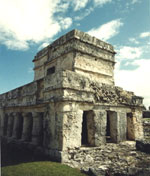
 |
John Pohl's MESOAMERICA |
|||
|
MAJOR ARCHAEOLOGICAL SITES: PreClassic to PostClassic TULÚM (circa A.D. 1450-1520) Following the abandonment of Chichén Itzá, a new Maya capital was founded 65 miles to the west at Mayapán in 1283. The city thrived under the domination of the Itzá until political dissent led to its own destruction around 1450. Subsequently, the Maya were divided into rival political factions of at least sixteen independent kingdoms. Tulúm, located on the peninsula's east coast, is one of the most remarkable of the Late PostClassic trading centers. Ritual life focused on the Castillo, clearly a local version of buildings known by the same name at both Chichén and Mayapán, and both were dedicated to Kulkulcan - the Maya name for Toltec's Quetzalcoatl.
|
||||
|
Text links to all pages at this site are available at the FAMSI INDEX |
||||
